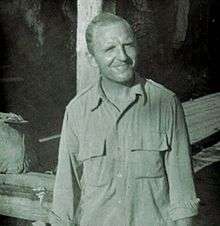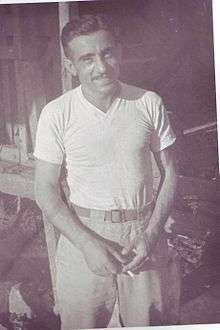45th Portable Surgical Hospital
The 45th Surgical Hospital was a United States military hospital that saw service in the China-Burma-India theater in World War II, Korea, and Vietnam.
| 45th Surgical Hospital | |
|---|---|
| Active | 1943-1945 1953-1954 1956-1970 |
| Country | US |
| Branch | Regular Army |
| Engagements | World War II Korean War Vietnam War |
| Commanders | |
| Notable commanders | Major Gary P. Wratton |
Lineage[1]
Activated 7 June 1943 at Camp White, Oregon as the 45th Portable Surgical Hospital
Inactivated 1945
Activated 1953 in Korea
Inactivated 1954
Activated 1956 at Fort Sam Houston Texas
Inactivated
Honors
Campaign Participation Credit
- World War II[2]
- Korean War
- Third Winter Campaign
- Summer-Fall 1953
- Vietnam
Distinctive Unit Insignia
Description
A silver color metal and enamel device 1 1/4 inches (3.18 cm) in height overall consisting of a black Chinthe astride a silver cross issuing from a Taeguk between two maroon fleams. All in front and below a stylized palm branch with two oak leaves proper.
Symbolism
Maroon and white are the colors used for the Medical Department. The Chinthe or Burmese griffin, taken from the seal of Burma, refers to the Hospital's service in that area during World War II. The Taeguk alludes to the Hospital's service in Korea and together with the two fleams (a heraldic surgical instrument used in early medicine) represents the two campaigns in Korea. The fleams and cross further symbolize the basic mission of the Surgical Hospital. The palm symbolizes long life and the oak leaves strength and bravery.
Background
The distinctive unit insignia was approved on 3 September 1969.
The original 45th PSH

The first 45th Portable Surgical Hospital was activated 31 May 1943 at Camp White, Oregon with 33 enlisted men and 4 officers who were surgeons. Captain Carl Whitbeck was the commanding officer, Captain Mainella was the adjutant. Captain Michael J. (Mike) Dardas, of Bay City Michigan, was one of the surgeons. A fourth surgeon joined the outfit late in 1943 and left before the hospital went over the Ledo Road to Burma. His replacement, Captain Katzinelson, a surgeon and anesthetist, joined after the unit arrived in China in December 1944.
A tragic mistake
The code number 9201V was assigned to the 45th PSH. The code number 9201T was assigned to the 44th PSH which was at Camp White. The orders for the two PSHs were received over the telephone and the V was mistaken for a T. These orders sent the 44th PSH to the East coast to be shipped overseas and the 45th to the West coast to ship out to India. This mistake was disastrous for the 44th and lucky for the 45th. The disaster was kept under wraps and the 45th first heard of it when the two hospitals met on the Ledo Road going to Burma.
The Rohna disaster
The 44th PSH was traveling on the HMT Rohna when disaster struck the convoy. HMT Rohna (named after a village in the Sonipat District of Punjab India) was the first troop ship carrying US troops to be sunk during World War II, on 26 November 1943. The ship sunk in the Mediterranean north of Bougie, Algeria following an air attack. The ship was destroyed by a radio controlled glide bomb, a Henschel Hs 293, launched and controlled by a Heinkel 177 bomber.
The ship was part of convoy KMF-26 (Annex) traveling east from Oran to the Far East via the Suez Canal. 1,138 men were lost, with 1,015 of them American troops. This still constitutes the largest loss of US troops at sea. A further 35 American troops of the 2000 originally on board later died of wounds. As well as the troops, 5 ship's officers and 117 seamen (of 200) died, along with 11 of the 12 gunners on board and 1 hospital orderly.
The heavy loss was in part due to a flotilla of seven empty LCI(L) (Landing Craft Infantry (Large)) craft failing to stop to pick up survivors, for which the commanding officer was relieved of his command. However, 606 survivors were rescued by the minesweeper USS Pioneer (AM-105). The loss was so devastating that it was classified until 1967. The full details were only released following the introduction of the Freedom of Information Act.
Overseas deployment
The 45th departed from Wilmington, California on the USS Hermitage (AP-54), a naval troop ship, in late November, 1943. Because the Hermitage was a fast ship, it sailed by itself and not in a convoy. Engine problems necessitated a stop for repairs at the island of Bora Bora in the south Pacific. Stops were made in Australia at Perth, where the Hermitage was joined by another troop ship. The ships arrived at Bombay, India (now called Mumbai) on 26 December 1943. The 45th debarked and went on a train that took them to Calcutta (now called Kolkata), where the 45th arrived on New Year's Eve, 1943. The hospital spent the night on a railroad siding and the next morning was transferred to Kanchrapara camp. The hospital was one of the first to use the camp. Several weeks later, the long trip to Assam started and ended with the 45th setting up a camp site outside Ledo Assam. Originally, the 45th was to fly the Hump to China, but orders were changed when the fighting in Burma created a need for the hospital's services.
The war in Burma

The front in southeast Asia was near Kamaing, Burma. The hospital set up in the jungle, and patients started arriving before setup was completed. It was a steady flow of wounded for three days that kept the surgeons constantly busy.
As the front moved forward, the hospital packed and moved into Kamaing. The Ledo Road was under construction, and with the onset of the rainy weather, progress in construction and travel was slow. It was in Kamaing where the hospital treated soldiers of Wingate’s Raiders. It was the first medical treatment for the Raiders who were dropped behind Japanese lines with the promise that they would be taken out in a couple of weeks. They had been behind the lines for 50 or more days and they had either walked out or floated out on the river.
The hospital moved to Mogaung in late spring 1944, where the operating room was set up in an old bombed out building near an old mill, which became living quarters for the men. The hospital went on part-time duty because the monsoon rains had brought the fighting to a standstill. During this lull in hospital work, several members of the 45th requested that they be circumcised. Captain Mainella granted their request.
The number of war casualties that were operated on decreased as each day passed and the hospital provided medical treatment for injuries or medical problems for the local population that were not due to the war. When the monsoon season came to an end, the PSH traveled by jeep train south to Mawlu. The 45th received orders to pack up and return to the airfield south of Mogaung where they would be transported by plane over the Hump to Kunming, China.
Kunming to Kwelin, China
The 45th arrived in Kunming on Christmas Eve only to stay on a mountain side for several hours due to a Japanese air raid alert. The unit stayed in a hostel while in Kunming, and as there was no hospital work to do, the unit took some time for rest and recuperation. The 45th moved out from Kunming on 28 January 1945. The destination was unknown since the Japanese were retreating. When they arrived at their destination, they were not expected. Finally they found a school house to use as a hospital. Most of the hospital work was on civilians and a few Chinese army accidents.
The trip to the front was made mostly by trucks except for the last 100 miles into Kwelin. This segment of the trip was made by boat, horseback, or walking. The group made a bivouac on a rim around Kweilin for several days, because the Chinese could see the Japanese retreat at night and did not want to engage them in more fighting. The local interpreter informed Major Whitbeck that a sign on a pill box said that the war had been over for 4 or 5 days. The unit had no radios available, so had not received any official information to confirm this.
The 45th flew out of Kweilin to Luichow, with plans to transport to Shanghai and then to Taiwan to take care of the prisoners of war. While in Luichow, there was a typhoid epidemic with a high death rate. The dead were seen lying on the streets, because the city had been evacuated and there was no one to care for the dead.
Most of the officers and the first three grades were sent home from Luichow. The 45th stayed in Shanghai for a short time. The 45th received new officers, who informed the outfit that it was again assigned to the Chinese Army. The hospital was ordered to go with the Chinese army to invade Formosa. It was expected that there would be some resistance from the Japanese Army. However, the invasion was accomplished without any war casualties.
Medical problems of the 45th hospital personnel
The 45th hospital personnel were lucky in that they had no casualties as a result of the war. There were many who were hospitalized, mostly for malaria, dysentery or "jungle rot". Hookworm infection was very common in the regions where the hospital was located, but only one case was reported after the men returned home. There were a couple cases of war anxiety which resulted in pensions and medical discharges. Many soldiers also became ill after returning home.
The unit was awarded several citations by the Chinese Army and government. The hospital personnel were awarded 4 bronze battles stars. Several were awarded the Silver Star and the Bronze Star. The original unit was in the China Burma India theatre for almost 2 years.
Korean War
Vietnam
The main body of the 45th arrived at Vung Tau, Vietnam on 4 October 1966. On 4 November 1966, the 45th's commanding officer, Major Gary P. Wratten, was killed during a mortar attack.[1]
See also
- List of former United States Army medical units
- Mobile Army Surgical Hospital
- Combat Support Hospital
References
- "History of the 45th Surgical Hospital". the45thsurg.freeservers.com.
- "1st45th". the45thsurg.freeservers.com.
- "Archived copy" (PDF). Archived from the original on 12 September 2014. Retrieved 19 March 2016.CS1 maint: archived copy as title (link)
- Theobald, Paul. About the 45th Portable Surgical Hospital 1943. Retrieved 1 March 2007.